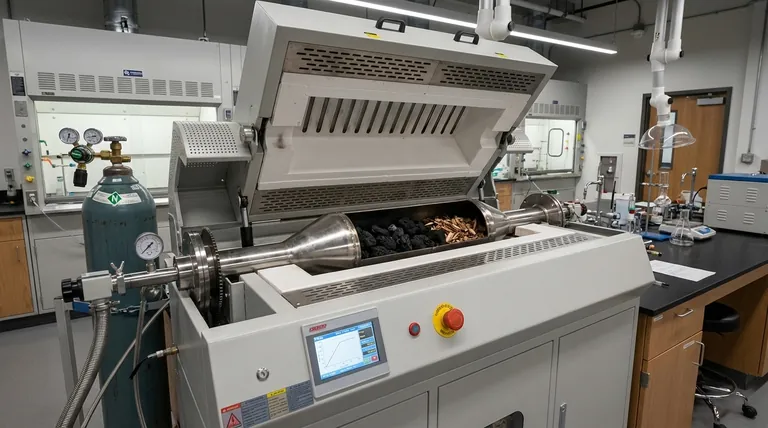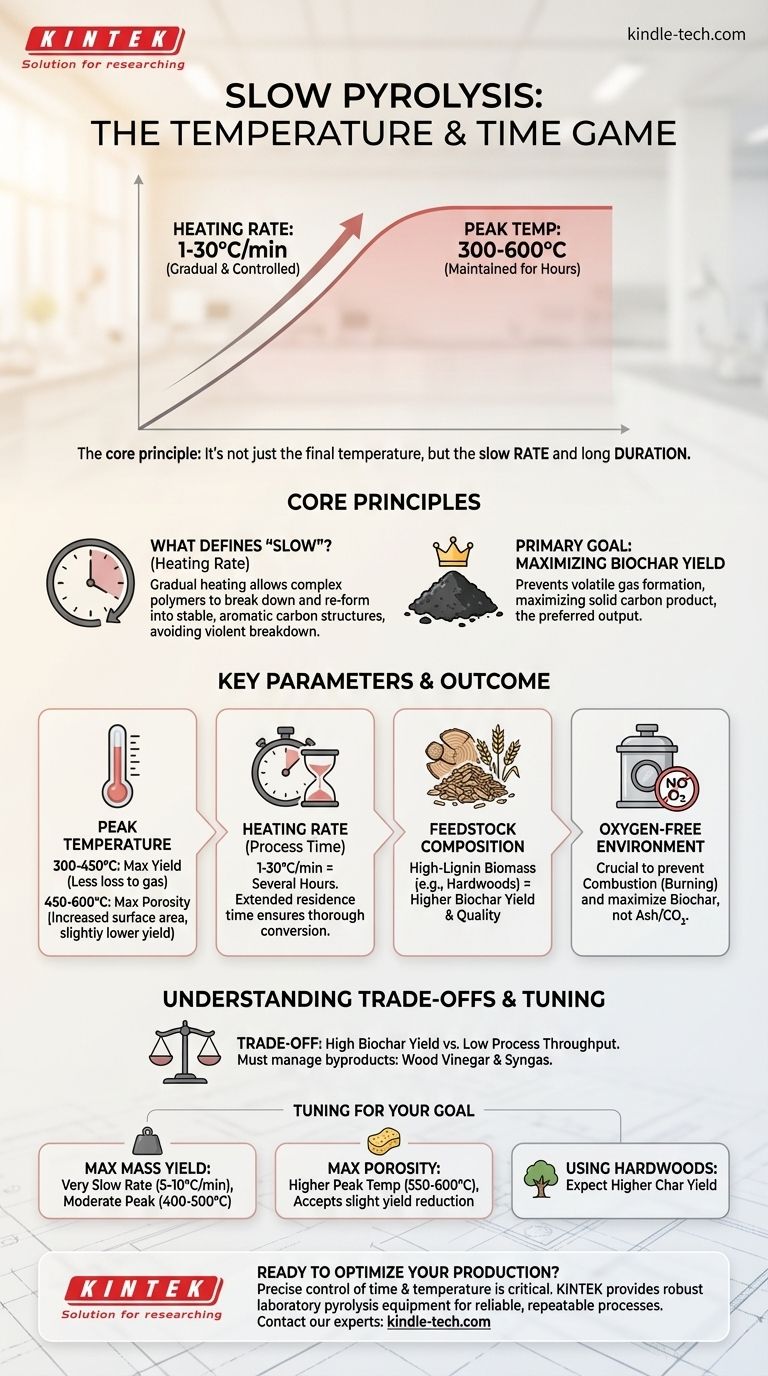In slow pyrolysis, the process is defined not by a single fixed time and temperature, but by a controlled, gradual heating rate, typically between 1 and 30°C per minute. The feedstock is heated in an oxygen-free environment to peak temperatures that commonly range from 300°C to 600°C. The total process time is a direct result of this slow rate, often lasting several hours to maximize the conversion of biomass into solid biochar.
The core principle of slow pyrolysis is not simply reaching a target temperature, but carefully controlling the heating rate over a long duration. This deliberate slowness is designed to maximize the yield of solid biochar by discouraging the formation of liquid and gas byproducts.

The Core Principles of Slow Pyrolysis
To understand the parameters of slow pyrolysis, you must first understand its primary objective. Unlike other thermal processes that aim to produce energy or liquid fuels, slow pyrolysis is engineered to produce a solid, carbon-rich product.
What Defines "Slow"?
The "slow" in slow pyrolysis refers directly to the heating rate. By heating the material gradually (1-30°C/min), the complex organic polymers within the biomass have sufficient time to break down and re-form into stable, aromatic carbon structures.
This stands in stark contrast to fast pyrolysis, where heating rates can be hundreds of degrees per second, intentionally "cracking" the molecules into vapors and aerosols to produce bio-oil.
The Primary Goal: Maximizing Biochar
The slow decomposition process is key to maximizing biochar yield. A gradual increase in temperature prevents the violent breakdown of organic matter into volatile gases.
Instead, molecules rearrange and condense, forming the stable, porous carbon lattice that constitutes high-quality biochar. This makes it the preferred method when the solid product is the most valuable output.
Key Parameters Influencing the Outcome
The final properties of your biochar are not accidental; they are a direct result of carefully managed process conditions. The relationship between these parameters determines the yield and quality of the final product.
Peak Temperature
While pyrolysis of wood can begin as low as 200-300°C, the process is typically carried out at higher peak temperatures.
- Lower End (300-450°C): This range generally maximizes the yield of biochar, as less carbon is lost to volatile gases.
- Higher End (450-600°C): Pushing the temperature higher can increase the biochar's porosity and surface area but may slightly decrease the overall mass yield.
Heating Rate (Process Time)
This is the most critical factor defining the process. A slower heating rate directly translates to a longer residence time for the feedstock at pyrolysis temperatures.
This extended duration ensures that the thermal decomposition is thorough, allowing for the maximum possible conversion to stable char.
Feedstock Composition
The type of biomass used is a crucial variable. Dense, woody materials with high lignin content (like hardwoods) will typically produce a higher yield of biochar compared to lighter materials with high cellulose content (like grasses or agricultural residues).
Oxygen-Free Environment
Slow pyrolysis must occur in an environment with little to no oxygen. The presence of oxygen would lead to combustion (burning), which would consume the biomass to produce ash, heat, and CO₂, rather than the desired biochar.
Understanding the Trade-offs
Choosing slow pyrolysis involves accepting a fundamental trade-off between the quality of your primary product and the efficiency of the process itself.
Yield vs. Throughput
Slow pyrolysis excels at producing a high yield of biochar from a given amount of feedstock. However, because the process takes hours to complete, its throughput (the amount of material processed per day) is inherently low. This is a critical consideration for any commercial-scale operation.
Product Simplicity vs. Complexity
While the goal is to produce biochar, the process still creates byproducts, including a liquid fraction (wood vinegar or bio-oil) and a combustible gas (syngas). An effective system must manage and ideally utilize all three output streams.
Tuning the Process for Your Goal
The optimal parameters for slow pyrolysis depend entirely on your desired outcome. Use these principles to guide your decisions.
- If your primary focus is maximizing the total mass yield of biochar: Utilize a very slow heating rate (e.g., 5-10°C/min) and a moderate peak temperature around 400-500°C.
- If your primary focus is producing a highly porous biochar for activation: Aim for a slightly higher peak temperature (e.g., 550-600°C), accepting a potential small reduction in overall yield.
- If your primary focus is using dense hardwoods: You can expect a higher char yield compared to other feedstocks under the same conditions.
Ultimately, slow pyrolysis is a process of deliberate control, where time and temperature are the levers used to transform biomass into stable, high-value biochar.
Summary Table:
| Parameter | Typical Range | Key Impact |
|---|---|---|
| Heating Rate | 1 - 30 °C per minute | Defines process slowness; maximizes biochar yield |
| Peak Temperature | 300 - 600 °C | Controls biochar porosity and final yield |
| Process Time | Several hours | Result of slow heating rate for thorough conversion |
| Feedstock | High-lignin biomass (e.g., hardwoods) | Influences the final biochar yield and quality |
Ready to optimize your biochar production? The precise control of time and temperature is critical for high-quality results. KINTEK specializes in robust laboratory pyrolysis equipment and consumables designed for reliable, repeatable processes.
Our systems provide the controlled environment necessary to achieve your specific biochar yield and quality goals. Contact our experts today to discuss how KINTEK can support your laboratory's pyrolysis and biomass conversion needs.
Visual Guide

Related Products
- Rotary Tube Furnace Split Multi Heating Zone Rotating Tube Furnace
- 1400℃ Laboratory Quartz Tube Furnace with Alumina Tube Tubular Furnace
- Laboratory Quartz Tube Furnace Tubular RTP Heating Furnace
- Vertical Laboratory Quartz Tube Furnace Tubular Furnace
- Vacuum Sealed Continuous Working Rotary Tube Furnace Rotating Tube Furnace
People Also Ask
- What are the advantages of a rotary furnace? Achieve Superior Homogeneity & Efficiency for Powders & Granules
- What are the advantages and disadvantages of rotary furnace? Maximize Uniformity & Efficiency in Thermal Processing
- What is the process of zirconium production? From Ore to High-Performance Metal & Ceramic
- How are tube furnaces classified based on the orientation of the tube? Choose the Right Design for Your Process
- What is a rotary heat type furnace? The Ultimate Guide to Uniform Heating & Mixing



















